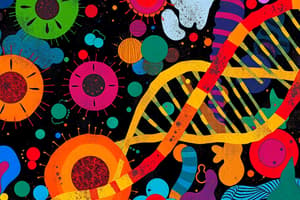Podcast
Questions and Answers
Which of the following best describes the central dogma of molecular biology?
Which of the following best describes the central dogma of molecular biology?
- Proteins are transcribed into RNA, which is translated into DNA
- RNA is transcribed into DNA, which is translated into protein
- Proteins are transcribed into DNA, which is translated into RNA
- DNA is transcribed into RNA, which is translated into protein (correct)
What is the function of histones in the packing of DNA?
What is the function of histones in the packing of DNA?
- To prevent DNA replication
- To promote mutations in the DNA sequence
- To introduce breaks in the DNA strands
- To stabilize the DNA structure (correct)
Which of the following is a characteristic of euchromatin?
Which of the following is a characteristic of euchromatin?
- It is tightly packed
- It contains highly condensed DNA
- It is transcriptionally inactive
- It is involved in active transcription (correct)
What term is used to describe an alternative version of a gene that can produce distinguishable phenotypic effects?
What term is used to describe an alternative version of a gene that can produce distinguishable phenotypic effects?
Which of the following represents a type of RNA involved in bringing amino acids to the ribosome for protein synthesis?
Which of the following represents a type of RNA involved in bringing amino acids to the ribosome for protein synthesis?
What type of chromosomal abnormality results from a change in the overall number of chromosomes, such as trisomy and monosomy?
What type of chromosomal abnormality results from a change in the overall number of chromosomes, such as trisomy and monosomy?
Which of the following best describes the composition of somatic cells?
Which of the following best describes the composition of somatic cells?
In a human haploid genome, approximately how many nucleotides are present?
In a human haploid genome, approximately how many nucleotides are present?
What is the function of colchicine in karyotyping?
What is the function of colchicine in karyotyping?
What is the main function of mRNA in the cell?
What is the main function of mRNA in the cell?
What is the approximate percentage of ribosomal RNAs in the total RNA of a cell?
What is the approximate percentage of ribosomal RNAs in the total RNA of a cell?
What is a characteristic feature of tRNA?
What is a characteristic feature of tRNA?
What is the function of microRNA (miRNA) in the cell?
What is the function of microRNA (miRNA) in the cell?
Which scientist first isolated DNA from pus on surgical bandages in 1869 and termed it 'nuclein'?
Which scientist first isolated DNA from pus on surgical bandages in 1869 and termed it 'nuclein'?
Which of the following statements about long noncoding RNAs (lncRNA) is true?
Which of the following statements about long noncoding RNAs (lncRNA) is true?
What is the role of small nuclear RNAs (snRNA) in the cell?
What is the role of small nuclear RNAs (snRNA) in the cell?
What is the process of copying and transferring genetic information to daughter cells called?
What is the process of copying and transferring genetic information to daughter cells called?
Which of the following statements is true about nucleic acids?
Which of the following statements is true about nucleic acids?
What do eukaryotic mRNAs consist of?
What do eukaryotic mRNAs consist of?
What is the main function of primers in DNA replication?
What is the main function of primers in DNA replication?
What do nucleotides consist of?
What do nucleotides consist of?
What is the function of ribosomes in the cell?
What is the function of ribosomes in the cell?
In DNA, which of the following nucleotide base pairs with thymine?
In DNA, which of the following nucleotide base pairs with thymine?
What is the most common form of DNA?
What is the most common form of DNA?
What process converts double-stranded DNA to single-stranded DNA?
What process converts double-stranded DNA to single-stranded DNA?
What does Tm refer to in the context of DNA?
What does Tm refer to in the context of DNA?
'Euchromatin' in eukaryotes is characterized as:
'Euchromatin' in eukaryotes is characterized as:
'Heterochromatin' in eukaryotes is characterized as:
'Heterochromatin' in eukaryotes is characterized as:
What is mitochondrial DNA?
What is mitochondrial DNA?
Flashcards are hidden until you start studying




